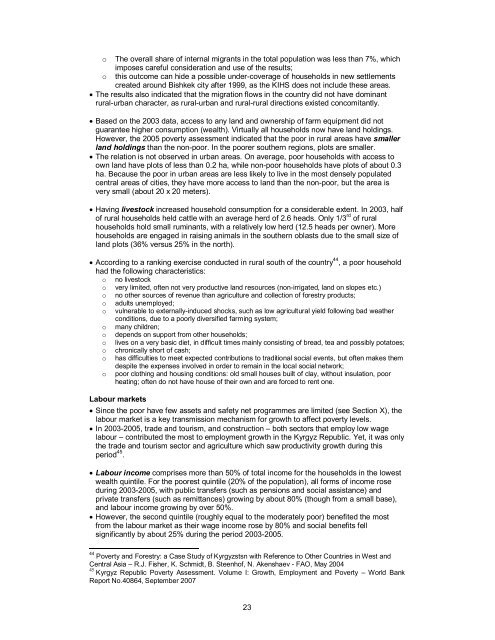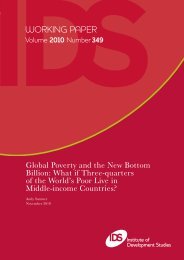secondary data review on the food security situation in the kyrgyz ...
secondary data review on the food security situation in the kyrgyz ...
secondary data review on the food security situation in the kyrgyz ...
You also want an ePaper? Increase the reach of your titles
YUMPU automatically turns print PDFs into web optimized ePapers that Google loves.
o The overall share of <strong>in</strong>ternal migrants <strong>in</strong> <strong>the</strong> total populati<strong>on</strong> was less than 7%, whichimposes careful c<strong>on</strong>siderati<strong>on</strong> and use of <strong>the</strong> results;o this outcome can hide a possible under-coverage of households <strong>in</strong> new settlementscreated around Bishkek city after 1999, as <strong>the</strong> KIHS does not <strong>in</strong>clude <strong>the</strong>se areas. The results also <strong>in</strong>dicated that <strong>the</strong> migrati<strong>on</strong> flows <strong>in</strong> <strong>the</strong> country did not have dom<strong>in</strong>antrural-urban character, as rural-urban and rural-rural directi<strong>on</strong>s existed c<strong>on</strong>comitantly. Based <strong>on</strong> <strong>the</strong> 2003 <str<strong>on</strong>g>data</str<strong>on</strong>g>, access to any land and ownership of farm equipment did notguarantee higher c<strong>on</strong>sumpti<strong>on</strong> (wealth). Virtually all households now have land hold<strong>in</strong>gs.However, <strong>the</strong> 2005 poverty assessment <strong>in</strong>dicated that <strong>the</strong> poor <strong>in</strong> rural areas have smallerland hold<strong>in</strong>gs than <strong>the</strong> n<strong>on</strong>-poor. In <strong>the</strong> poorer sou<strong>the</strong>rn regi<strong>on</strong>s, plots are smaller. The relati<strong>on</strong> is not observed <strong>in</strong> urban areas. On average, poor households with access toown land have plots of less than 0.2 ha, while n<strong>on</strong>-poor households have plots of about 0.3ha. Because <strong>the</strong> poor <strong>in</strong> urban areas are less likely to live <strong>in</strong> <strong>the</strong> most densely populatedcentral areas of cities, <strong>the</strong>y have more access to land than <strong>the</strong> n<strong>on</strong>-poor, but <strong>the</strong> area isvery small (about 20 x 20 meters). Hav<strong>in</strong>g livestock <strong>in</strong>creased household c<strong>on</strong>sumpti<strong>on</strong> for a c<strong>on</strong>siderable extent. In 2003, halfof rural households held cattle with an average herd of 2.6 heads. Only 1/3 rd of ruralhouseholds hold small rum<strong>in</strong>ants, with a relatively low herd (12.5 heads per owner). Morehouseholds are engaged <strong>in</strong> rais<strong>in</strong>g animals <strong>in</strong> <strong>the</strong> sou<strong>the</strong>rn oblasts due to <strong>the</strong> small size ofland plots (36% versus 25% <strong>in</strong> <strong>the</strong> north). Accord<strong>in</strong>g to a rank<strong>in</strong>g exercise c<strong>on</strong>ducted <strong>in</strong> rural south of <strong>the</strong> country 44 , a poor householdhad <strong>the</strong> follow<strong>in</strong>g characteristics:o no livestocko very limited, often not very productive land resources (n<strong>on</strong>-irrigated, land <strong>on</strong> slopes etc.)o no o<strong>the</strong>r sources of revenue than agriculture and collecti<strong>on</strong> of forestry products;o adults unemployed;o vulnerable to externally-<strong>in</strong>duced shocks, such as low agricultural yield follow<strong>in</strong>g bad wea<strong>the</strong>rc<strong>on</strong>diti<strong>on</strong>s, due to a poorly diversified farm<strong>in</strong>g system;o many children;o depends <strong>on</strong> support from o<strong>the</strong>r households;o lives <strong>on</strong> a very basic diet, <strong>in</strong> difficult times ma<strong>in</strong>ly c<strong>on</strong>sist<strong>in</strong>g of bread, tea and possibly potatoes;o chr<strong>on</strong>ically short of cash;o has difficulties to meet expected c<strong>on</strong>tributi<strong>on</strong>s to traditi<strong>on</strong>al social events, but often makes <strong>the</strong>mdespite <strong>the</strong> expenses <strong>in</strong>volved <strong>in</strong> order to rema<strong>in</strong> <strong>in</strong> <strong>the</strong> local social network;o poor cloth<strong>in</strong>g and hous<strong>in</strong>g c<strong>on</strong>diti<strong>on</strong>s: old small houses built of clay, without <strong>in</strong>sulati<strong>on</strong>, poorheat<strong>in</strong>g; often do not have house of <strong>the</strong>ir own and are forced to rent <strong>on</strong>e.Labour markets S<strong>in</strong>ce <strong>the</strong> poor have few assets and safety net programmes are limited (see Secti<strong>on</strong> X), <strong>the</strong>labour market is a key transmissi<strong>on</strong> mechanism for growth to affect poverty levels. In 2003-2005, trade and tourism, and c<strong>on</strong>structi<strong>on</strong> – both sectors that employ low wagelabour – c<strong>on</strong>tributed <strong>the</strong> most to employment growth <strong>in</strong> <strong>the</strong> Kyrgyz Republic. Yet, it was <strong>on</strong>ly<strong>the</strong> trade and tourism sector and agriculture which saw productivity growth dur<strong>in</strong>g thisperiod 45 . Labour <strong>in</strong>come comprises more than 50% of total <strong>in</strong>come for <strong>the</strong> households <strong>in</strong> <strong>the</strong> lowestwealth qu<strong>in</strong>tile. For <strong>the</strong> poorest qu<strong>in</strong>tile (20% of <strong>the</strong> populati<strong>on</strong>), all forms of <strong>in</strong>come rosedur<strong>in</strong>g 2003-2005, with public transfers (such as pensi<strong>on</strong>s and social assistance) andprivate transfers (such as remittances) grow<strong>in</strong>g by about 80% (though from a small base),and labour <strong>in</strong>come grow<strong>in</strong>g by over 50%. However, <strong>the</strong> sec<strong>on</strong>d qu<strong>in</strong>tile (roughly equal to <strong>the</strong> moderately poor) benefited <strong>the</strong> mostfrom <strong>the</strong> labour market as <strong>the</strong>ir wage <strong>in</strong>come rose by 80% and social benefits fellsignificantly by about 25% dur<strong>in</strong>g <strong>the</strong> period 2003-2005.44 Poverty and Forestry: a Case Study of Kyrgyzstsn with Reference to O<strong>the</strong>r Countries <strong>in</strong> West andCentral Asia – R.J. Fisher, K. Schmidt, B. Steenhof, N. Akenshaev - FAO, May 200445 Kyrgyz Republic Poverty Assessment. Volume I: Growth, Employment and Poverty – World BankReport No.40864, September 200723
















